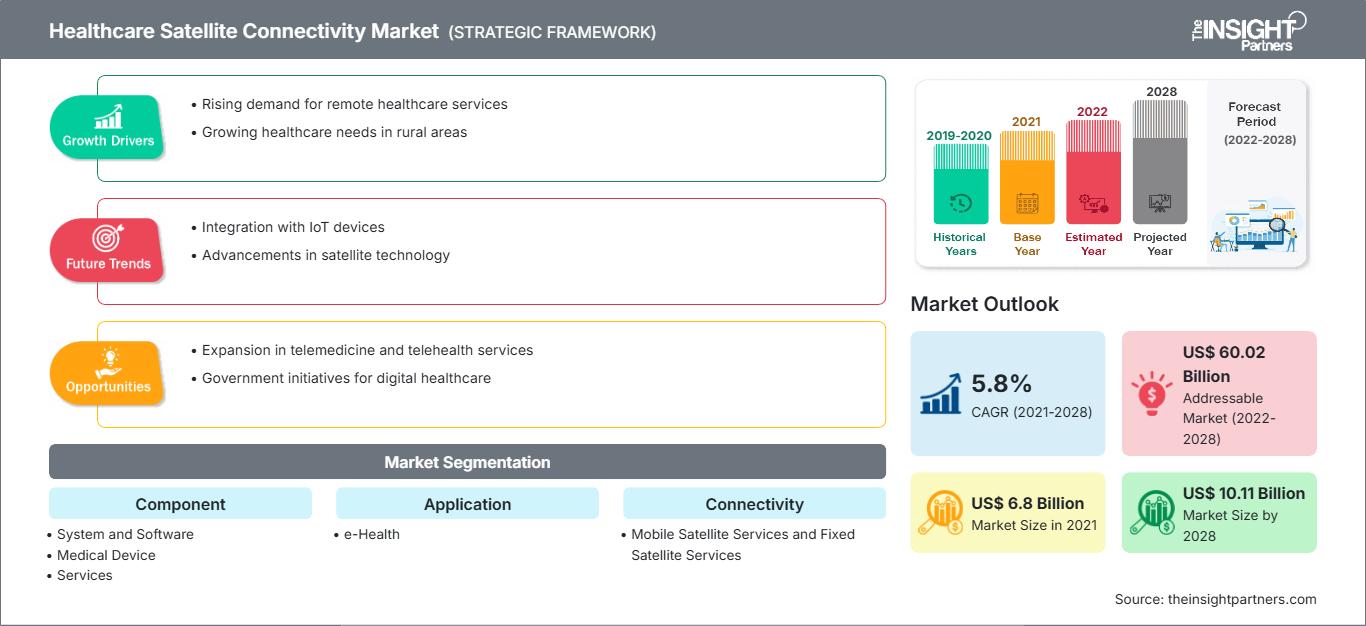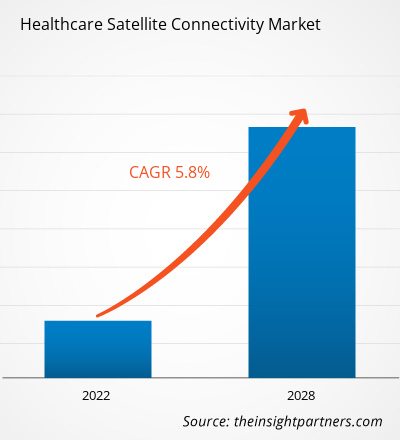Si prevede che il mercato dei satelliti sanitari crescerà da 6.797,22 milioni di dollari nel 2021 a 10.105,21 milioni di dollari entro il 2028; si stima una crescita a un CAGR del 5,8% dal 2021 al 2028.
La connettività satellitare sanitaria consente diagnosi e cure mediche a distanza nel comfort della propria casa. Consente l'imaging digitale, il monitoraggio remoto dei pazienti, l'e-learning e la consulenza, nonché l'accesso a sessioni di assistenza per migliorare le conoscenze dei professionisti medici che si trovano a distanza.
La crescita del mercato della connettività satellitare sanitaria è attribuita a fattori quali le iniziative governative per la promozione e lo sviluppo di soluzioni basate sulla connettività satellitare in ambito sanitario e la crescente adozione dell'e-Health. Tuttavia, le preoccupazioni relative alla privacy dei dati ostacolano la crescita del mercato.
Approfondimenti di mercato: Crescita del settore IT sanitario nelle economie emergenti
Personalizza questo rapporto in base alle tue esigenze
Potrai personalizzare gratuitamente qualsiasi rapporto, comprese parti di questo rapporto, o analisi a livello di paese, pacchetto dati Excel, oltre a usufruire di grandi offerte e sconti per start-up e università
Mercato della connettività satellitare sanitaria: Approfondimenti strategici

- Ottieni le principali tendenze chiave del mercato di questo rapporto.Questo campione GRATUITO includerà l'analisi dei dati, che vanno dalle tendenze di mercato alle stime e alle previsioni.
Potrai personalizzare gratuitamente qualsiasi rapporto, comprese parti di questo rapporto, o analisi a livello di paese, pacchetto dati Excel, oltre a usufruire di grandi offerte e sconti per start-up e università
Mercato della connettività satellitare sanitaria: Approfondimenti strategici

- Ottieni le principali tendenze chiave del mercato di questo rapporto.Questo campione GRATUITO includerà l'analisi dei dati, che vanno dalle tendenze di mercato alle stime e alle previsioni.
I sistemi sanitari stanno registrando un crescente coinvolgimento dei consumatori in tutto il mondo. Nei paesi in via di sviluppo, i sistemi stanno diventando tecnologicamente più amichevoli. Questi paesi stanno assistendo a un'internazionalizzazione dell'assistenza sanitaria, poiché marchi affermati – come la Cleveland Clinic con sede negli Stati Uniti – hanno ampliato le loro attività negli Emirati Arabi Uniti, e start-up – come Babylon, un'app di diagnostica per l'assistenza primaria basata su apprendimento automatico e intelligenza artificiale, con sede in Inghilterra – sono entrate nei mercati di Cina e Ruanda. Inoltre, con i crescenti investimenti nel settore sanitario dell'area Asia-Pacifico, le start-up IT offrono opportunità redditizie per la sua crescita. Ad esempio, a dicembre 2020, DXY (un portale sanitario cinese) ha raccolto 500 milioni di dollari in un round di Serie E guidato da Trustbridge Partners. Alodokter, una piattaforma tecnologica sanitaria indonesiana, ha raccolto 33 milioni di dollari di finanziamenti di Serie C. Si prevede che la crescita del settore IT sanitario nell'area Asia-Pacifico offrirà opportunità redditizie agli operatori per espandere le proprie capacità in tutta la regione. Inoltre, la pandemia di COVID-19 ha accelerato l'uso delle tecnologie sanitarie digitali a livello globale. La pandemia ha dato priorità alle soluzioni di monitoraggio remoto. I governi dell'area stanno promuovendo l'uso della telemedicina. Ad esempio, a marzo 2020, il governo indiano ha emanato le Linee guida per la pratica della telemedicina per consentire ai medici abilitati di fornire servizi sanitari utilizzando le telecomunicazioni e le tecnologie digitali. Tali iniziative offrirebbero opportunità redditizie per la crescita del mercato dei portali per i pazienti nei prossimi anni.
Approfondimenti basati sui componenti
Il mercato della connettività satellitare sanitaria, in base ai componenti, è segmentato in dispositivi medici, sistemi e software e servizi. Nel 2021, il segmento dei sistemi e del software deteneva la quota maggiore del mercato. Si prevede che lo stesso segmento registrerà il CAGR più elevato tra il 2021 e il 2028.
Approfondimenti basati sulle applicazioni
In base alle applicazioni, il mercato della connettività satellitare sanitaria è suddiviso in e-Health e altri settori. Nel 2021, il segmento e-Health ha detenuto una quota di mercato maggiore. Tuttavia, si prevede che gli altri segmenti registreranno un CAGR più elevato nel mercato nei prossimi anni.
Approfondimenti basati sulla connettività
In base alla connettività, il mercato della connettività satellitare sanitaria è suddiviso in servizi satellitari mobili e servizi satellitari fissi. Nel 2021, il segmento dei servizi satellitari fissi ha detenuto una quota di mercato maggiore. D'altro canto, si prevede che il segmento dei servizi satellitari mobili registrerà un CAGR più elevato nel mercato durante il periodo di previsione.
Approfondimenti basati sull'utente finale
In base all'utente finale, il mercato della connettività satellitare sanitaria è segmentato in organizzazioni di ricerca clinica, ospedali e cliniche, laboratori di ricerca e diagnostica e altri. Nel 2021, il segmento ospedali e cliniche ha detenuto la quota di mercato maggiore. Tuttavia, si prevede che il segmento delle organizzazioni di ricerca clinica registrerà il CAGR più elevato del mercato nei prossimi anni.
Il lancio e l'approvazione di prodotti sono strategie comunemente adottate dalle aziende per espandere la propria presenza globale e il proprio portafoglio prodotti. Inoltre, gli operatori del mercato della connettività satellitare sanitaria si concentrano sulla strategia di partnership per ampliare la propria clientela, il che, a sua volta, consente loro di mantenere il proprio marchio a livello globale.
Approfondimenti regionali sul mercato della connettività satellitare sanitaria
Le tendenze e i fattori regionali che influenzano il mercato della connettività satellitare sanitaria durante il periodo di previsione sono stati ampiamente spiegati dagli analisti di The Insight Partners. Questa sezione illustra anche i segmenti e la geografia del mercato della connettività satellitare sanitaria in Nord America, Europa, Asia-Pacifico, Medio Oriente e Africa, America meridionale e centrale.
Ambito del rapporto di mercato sulla connettività satellitare sanitaria
| Attributo del rapporto | Dettagli |
|---|---|
| Dimensioni del mercato in 2021 | US$ 6.8 Billion |
| Dimensioni del mercato per 2028 | US$ 10.11 Billion |
| CAGR globale (2021 - 2028) | 5.8% |
| Dati storici | 2019-2020 |
| Periodo di previsione | 2022-2028 |
| Segmenti coperti |
By Componente
|
| Regioni e paesi coperti | Nord America
|
| Leader di mercato e profili aziendali chiave |
|
Densità degli operatori del mercato della connettività satellitare sanitaria: comprendere il suo impatto sulle dinamiche aziendali
Il mercato della connettività satellitare per l'assistenza sanitaria è in rapida crescita, trainato dalla crescente domanda degli utenti finali, dovuta a fattori quali l'evoluzione delle preferenze dei consumatori, i progressi tecnologici e una maggiore consapevolezza dei vantaggi del prodotto. Con l'aumento della domanda, le aziende stanno ampliando la propria offerta, innovando per soddisfare le esigenze dei consumatori e sfruttando le tendenze emergenti, alimentando ulteriormente la crescita del mercato.

- Ottieni il Mercato della connettività satellitare sanitaria Panoramica dei principali attori chiave
- Sistema e software
- Gestione dispositivi remoti
- Gestione larghezza di banda di rete
- Analisi dati
- Sicurezza delle applicazioni
- Sicurezza di rete
- Dispositivo medico
- Dispositivo esterno indossabile
- Dispositivo medico impiantato
- Dispositivo medico fisso
- Servizi
- Servizi di integrazione di sistema
- Consulenza
- Formazione e istruzione
- Servizi di supporto e manutenzione
Mercato della connettività satellitare sanitaria - per applicazione
- e-Health
- Telemedicina
- Operazioni cliniche
- Altro
Mercato della connettività satellitare sanitaria - per connettività
- Servizi satellitari mobili
- Servizi satellitari fissi
Mercato della connettività satellitare sanitaria - per utente finale
- Organizzazioni di ricerca clinica
- Ospedali e cliniche
- Laboratori di ricerca e diagnostica
- Altro
Mercato della connettività satellitare sanitaria - per utente finale
- Organizzazioni di ricerca clinica
- Ospedali e cliniche
- Laboratori di ricerca e diagnostica
- Altro
Mercato della connettività satellitare sanitaria - per utente finale per Geografia
- Nord America
- Stati Uniti
- Canada
- Messico
- Europa
- Regno Unito
- Germania
- Francia
- Italia
- Spagna
- Resto d'Europa
- Asia Pacifico
- Cina
- Giappone
- India
- Australia
- Corea del Sud
- Resto dell'Asia Pacifico
- Medio Oriente e Africa
- Emirati Arabi Uniti
- Arabia Saudita
- Sudafrica
- Resto del Medio Oriente e dell'Africa
- America meridionale e centrale
- Brasile
- Argentina
- Resto dell'America meridionale e centrale America
Profili aziendali
- Inmarsat Global Limited
- Hughes Network Systems
- SES SA
- X2nSat
- Expedition Communications
- Globalstar
- EUTELSAT COMMUNICations SA
- AT&T Proprietà intellettuale
- DISH Network LLC
- Ligado Networks
- Analisi storica (2 anni), anno base, previsione (7 anni) con CAGR
- Analisi PEST e SWOT
- Valore/volume delle dimensioni del mercato - Globale, Regionale, Nazionale
- Industria e panorama competitivo
- Set di dati Excel
Report recenti
Rapporti correlati
Testimonianze
Motivo dell'acquisto
- Processo decisionale informato
- Comprensione delle dinamiche di mercato
- Analisi competitiva
- Analisi dei clienti
- Previsioni di mercato
- Mitigazione del rischio
- Pianificazione strategica
- Giustificazione degli investimenti
- Identificazione dei mercati emergenti
- Miglioramento delle strategie di marketing
- Aumento dell'efficienza operativa
- Allineamento alle tendenze normative






















 Ottieni un campione gratuito per - Mercato della connettività satellitare sanitaria
Ottieni un campione gratuito per - Mercato della connettività satellitare sanitaria